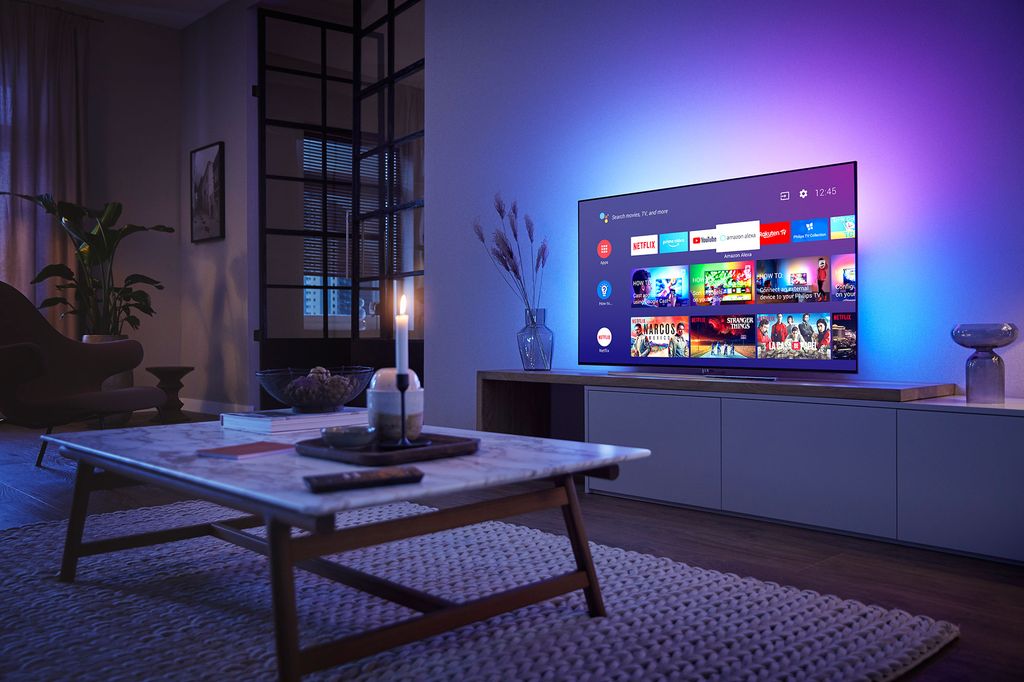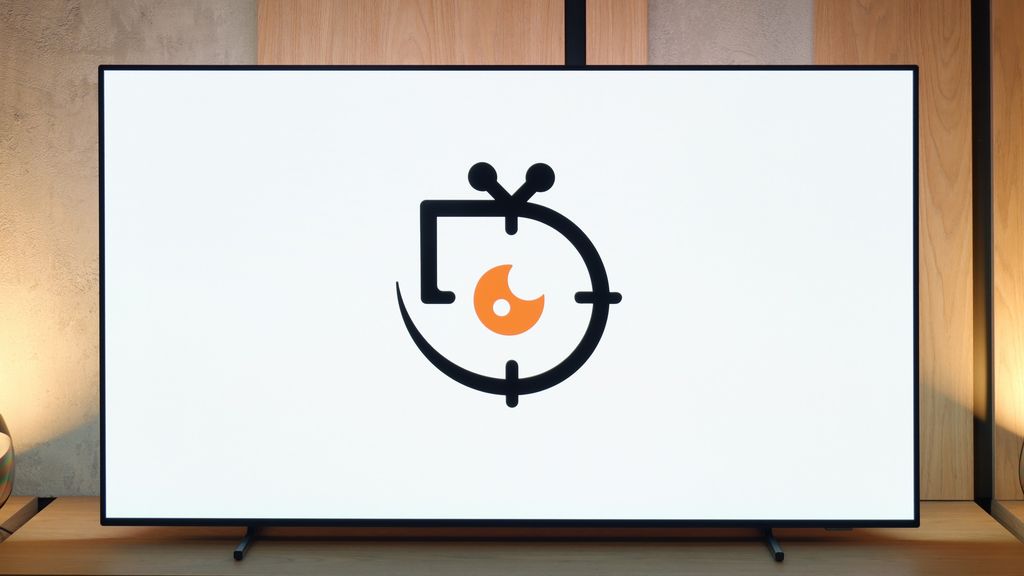- Matching (Score)
- Our verdict
- Competing TVs
- TV appearance
- Where to buy
- Contrast and black detail
- HDR effect quality
- Factory color reproduction
- Color reproduction after calibration
- Smoothness of tonal transitions
- Image scaling and smoothness of tonal transitions
- Blur and motion smoothness
- Console compatibility and gaming features
- Input lag
- Compatibility with PC
- Viewing angles
- TV efficiency during daytime
- TV features
- Apps
- Playing files from USB
- Sound
- Details about the matrix
PHILPS PUS9060 Review
The One 2025 / PUS9060 / PUS9000
Available screen sizes:
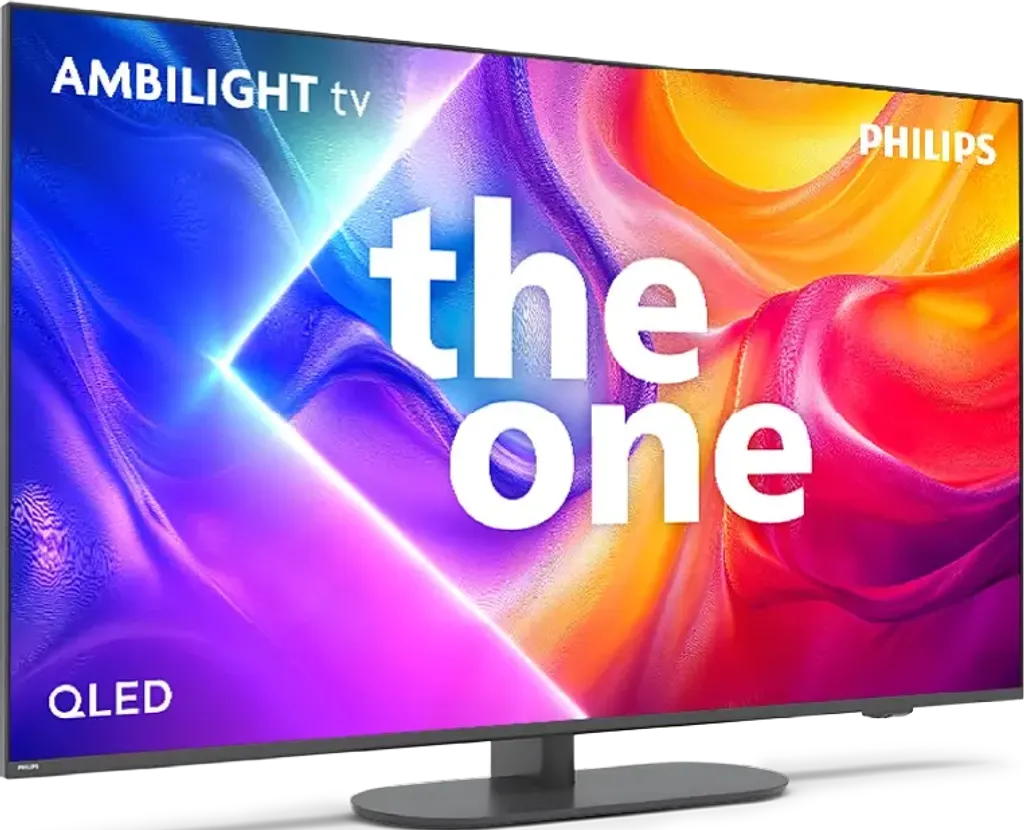
Complete the survey to find out the result
Panel type: LCD VA Refresh rate: 144Hz Brand: PHILIPS Resolution: 3840x2160 System: Titan OS Model year: 2025
PUS9060, also known as The One 2025, is the successor to the model we tested, PUS8909 from 2024. That TV debuted with a completely new operating system, Titan OS, which – to put it mildly – had a rocky start. Issues with responsiveness, an unfinished menu, and a limited number of apps could cause a bit of frustration. The new model from 2025 still offers very similar specifications, and its hallmark remains the Ambilight TV system, which many users believe is something essential for watching films in the evening. But is the PUS9060 from 2025 better than its predecessor? What improvements have been made to Titan OS, and what still needs work? We invite you to read our full review.
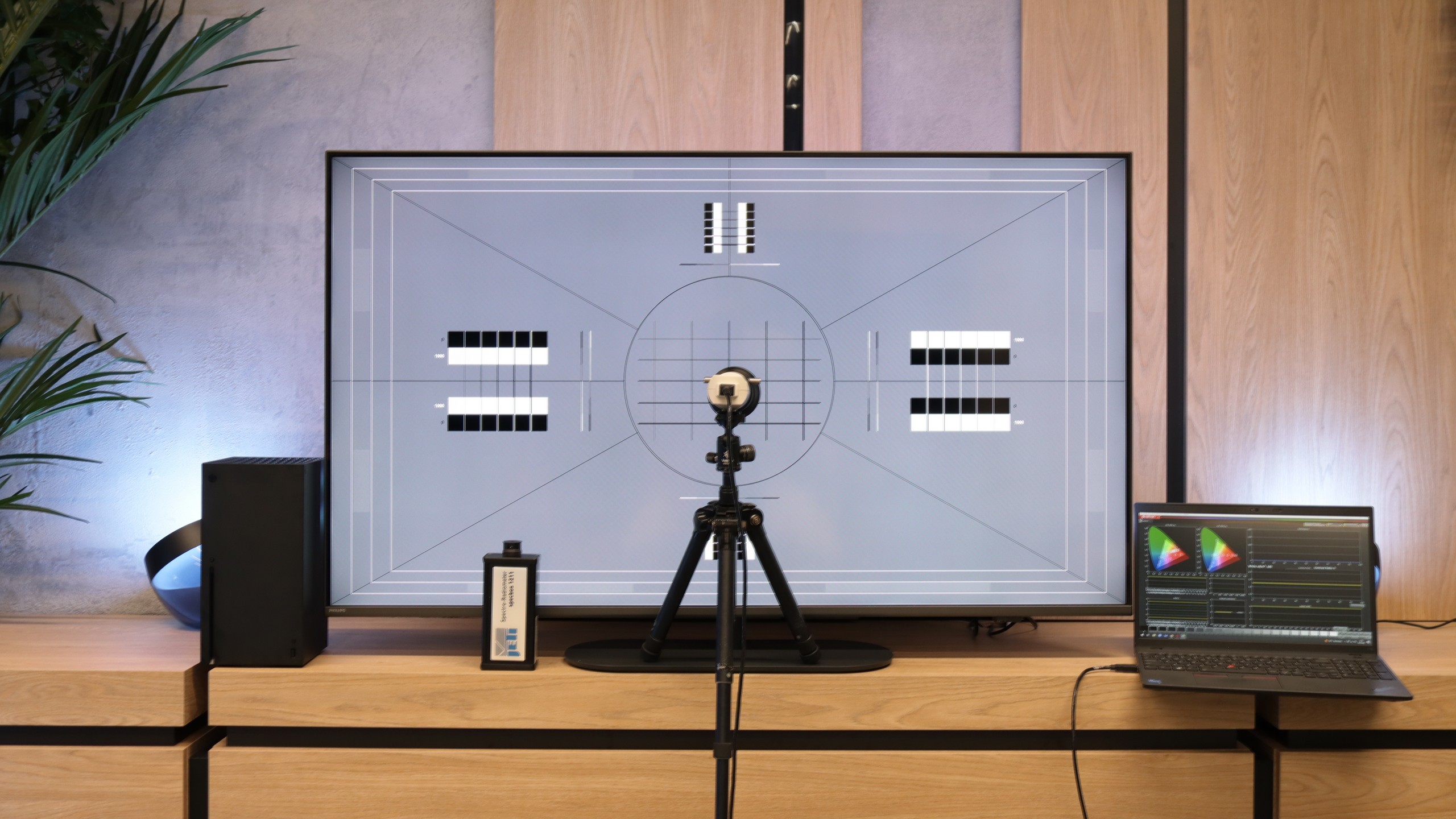
PHILIPS PUS9000 - Our verdict
6.8
Overall rating
Philips PUS9000 is proof that the manufacturer not only keeps a finger on the pulse but also carefully listens to its users. In the latest version of this popular series, there is a clear progression – especially in comparison to the previous generation that we had the opportunity to test. The use of a VA panel has brought noticeable improvement in blacks, which finally presents itself at a decent level. Brightness reaching 500 nits does not disappoint even in sunny rooms, and support for a wide range of HDR formats – including Dolby Vision and HDR10+ – completes the image of a well-prepared piece of equipment. Additionally, the support for spatial sound technologies like Dolby Atmos and DTS only enhances the positive impression, especially since the presence of all the aforementioned formats is not a given even in the most expensive models from 2025. But what really sets this model apart from the competition is the Ambilight system. The multicoloured backlighting not only makes a visual impression – in a darkened room, it can improve the perceived contrast and completely transform the viewing experience of a movie or series. The gaming mode also deserves recognition. 144 Hz, low input lag, variable refresh rate, G-Sync compatibility, and Game Bar functionality – everything you could expect from equipment designed with consoles and PCs in mind. Unfortunately, not everything works perfectly. The Titan OS system, while operating relatively smoothly, still suffers from shortcomings – many popular apps are missing, minor bugs occur, and the overall experience can be somewhat clunky in daily use. Additionally, the remote, despite its modern appearance, still uses infrared and requires pointing at the TV. Such a shame.
So, who is the PUS9060 for? For those who want to immerse themselves in an evening screening with impressive Ambilight, play on consoles, and stream content from external devices. In this scenario, “The One” could indeed turn out to be “the one and only” – especially given that its price is not off-putting on release day.
Advantages
VA panel with very good native contrast
Ambilight TV system that enhances perceived contrast
Support for dynamic HDR formats: Dolby Vision and HDR10+
Great for gamers: Supports 4K 120/144 Hz, VRR, ALLM, HGiG, G-Sync Compatible
Low input lag
Very good compatibility with PC
Supports multiple audio formats - Dolby Atmos and DTS
Backlit remote with numeric keypad
Disadvantages
The Titan OS operating system can be underdeveloped
Limited number of applications
Average viewing angles
Lack of TV functions (USB recording, PIP, Audio only mode)
Infrared remote (must aim at the screen)
Movies and series in UHD quality
6.7
Classic TV, YouTube
6.5
Sports broadcasts (TV and apps)
6.6
Gaming on console
8.4
TV as a computer monitor
8.8
Watching in bright light
6.0
Utility functions
5.9
Apps
6.2
Sound quality
6.6
Complete the survey to find out what fits your preferences
PHILIPS PUS9000 - Competing TVs in this price range
PHILIPS PUS9000 - TV appearance
HDMI inputs: 0 x HDMI 2.0, 4 x HDMI 2.1 (48Gbps) Other inputs: Toslink (Optical audio) Outputs: Toslink (Optical audio), eARC (HDMI), ARC (HDMI), Mini-Jack (Headphones) Network Interfaces: Wi-Fi 2.4GHz, Wi-Fi 5GHz, Ethernet (LAN) 100Mbps
Build quality: BuildQuality-Good
Stand type: Central
Bezel colour: Graphite
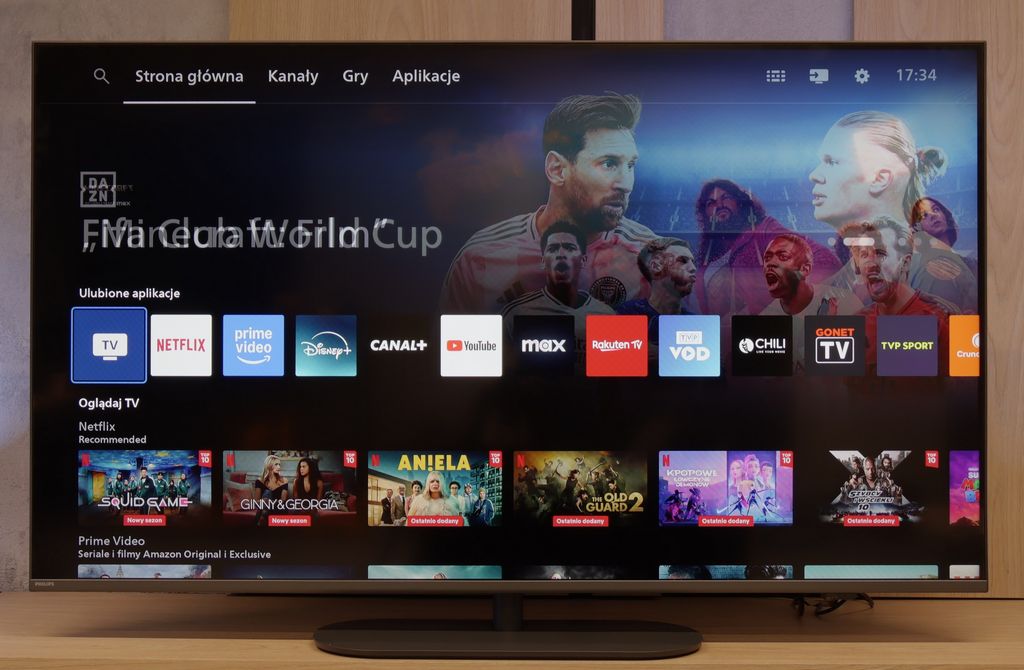
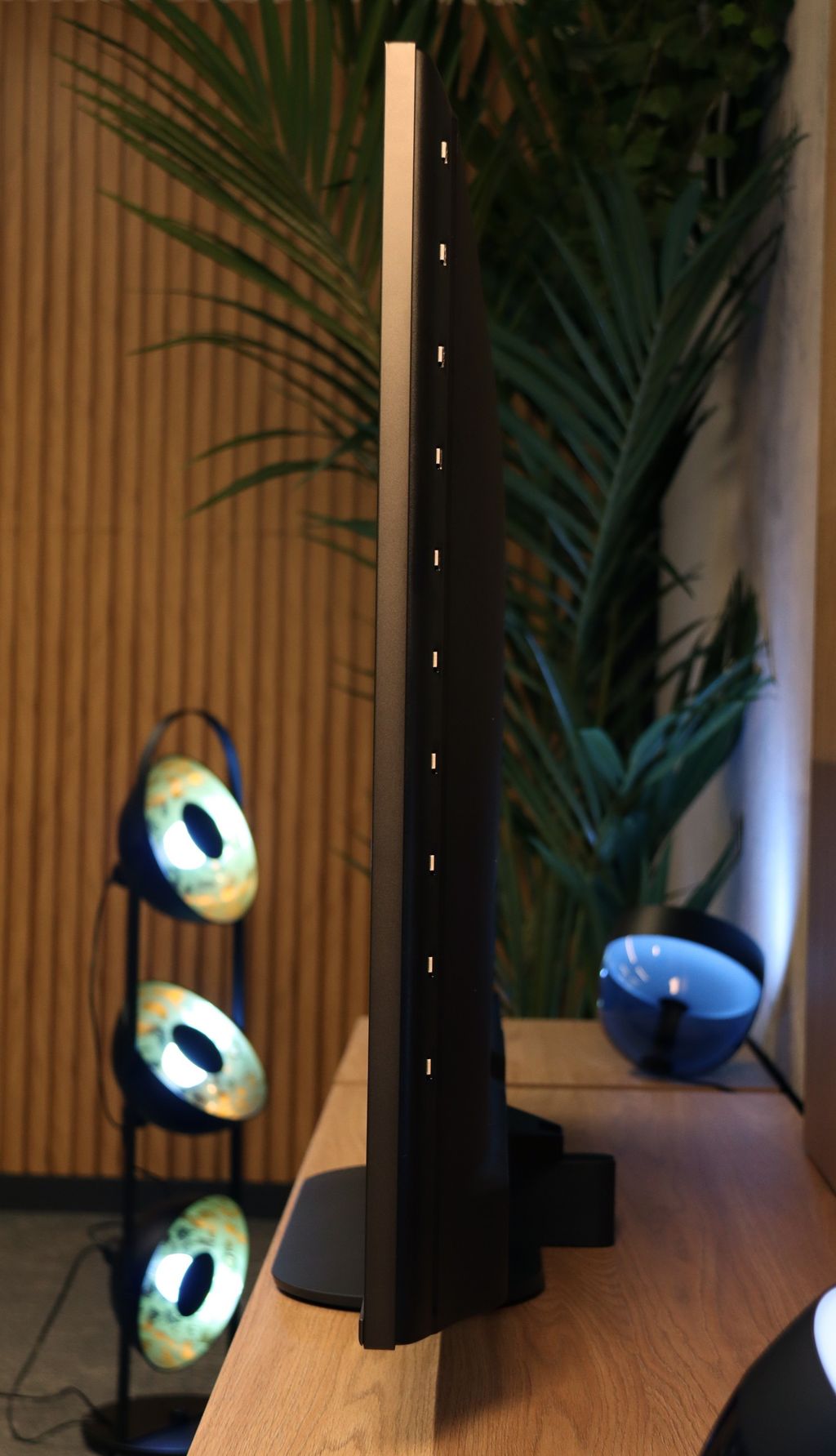
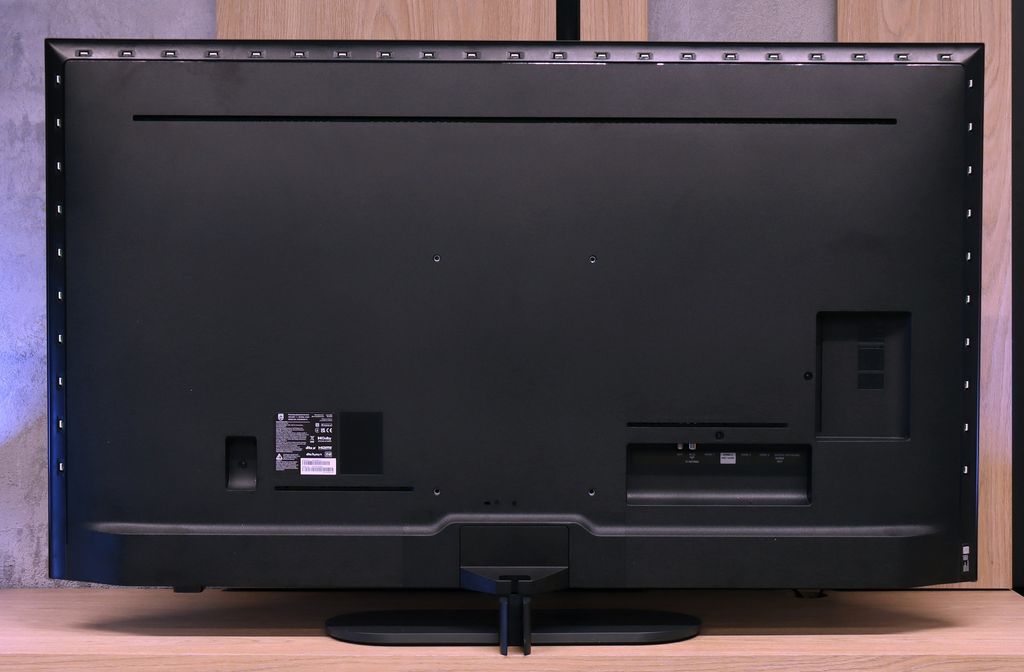
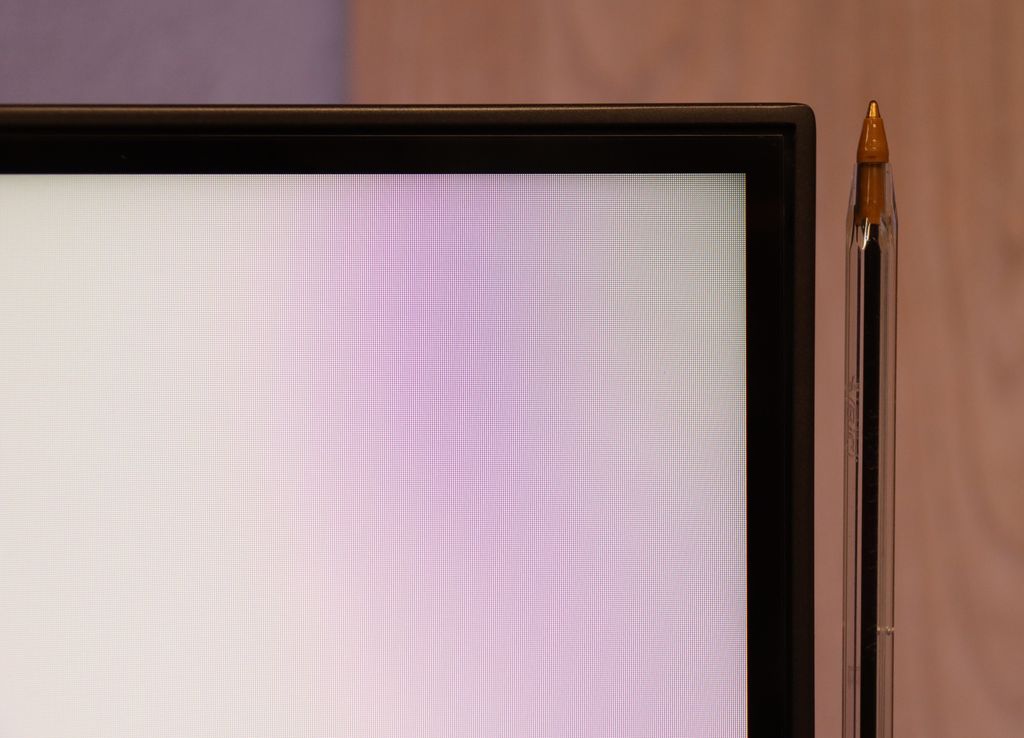
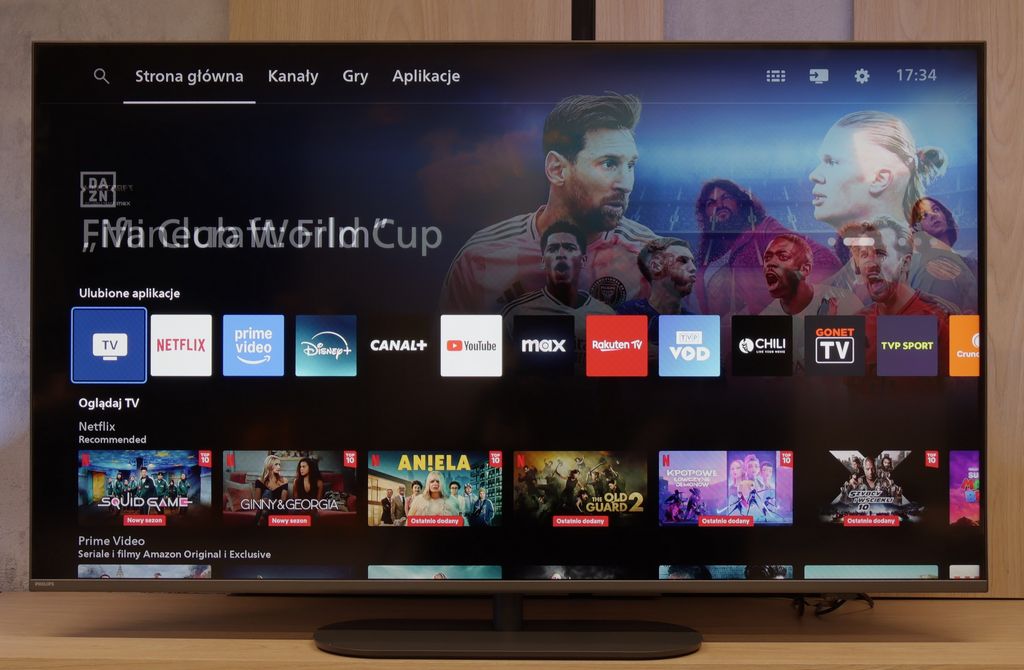
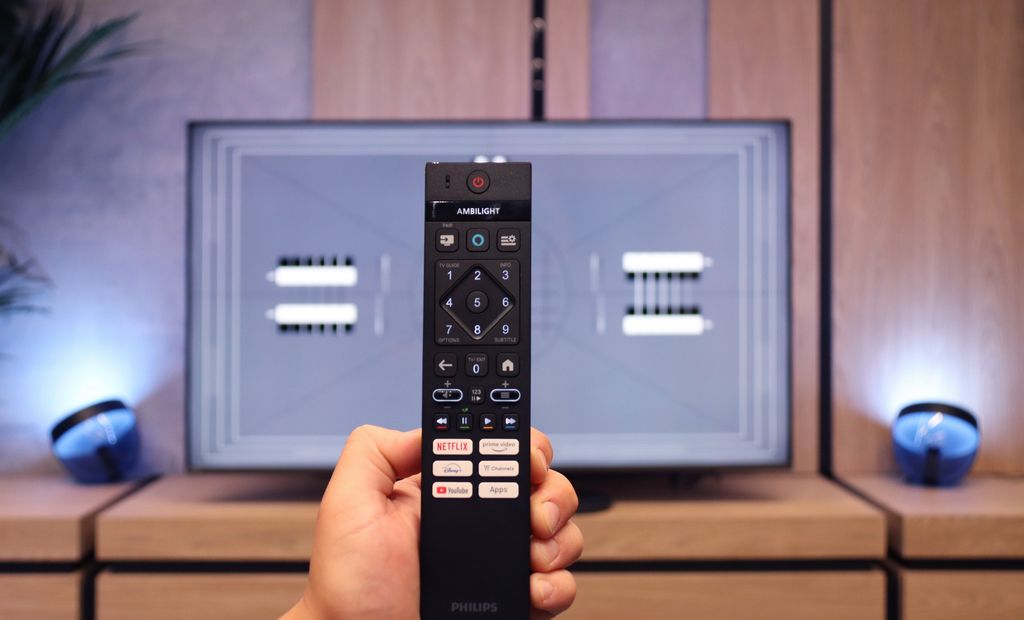
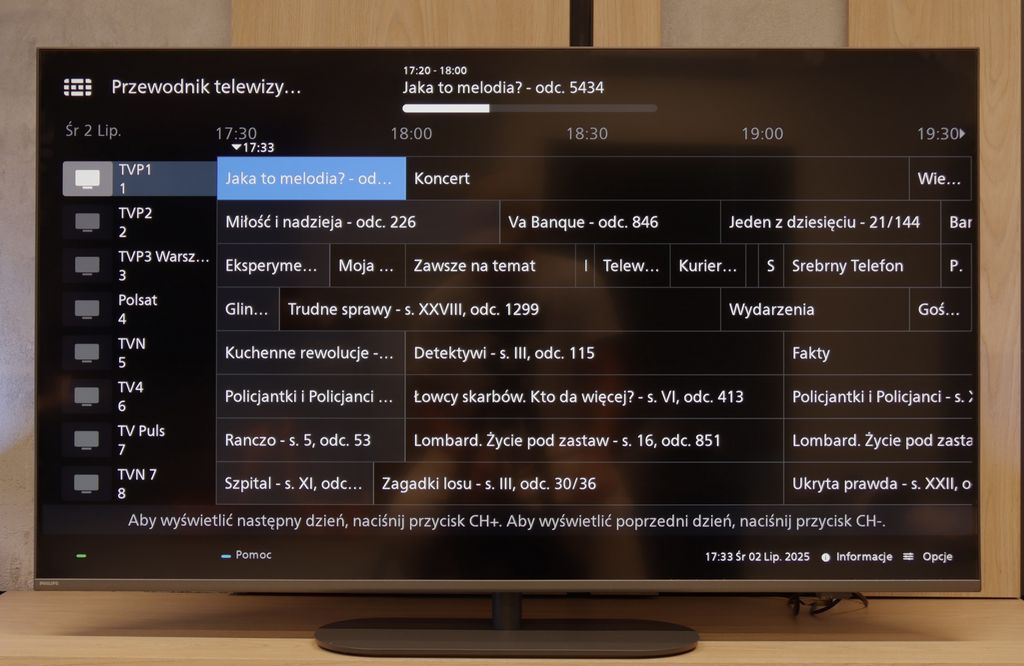
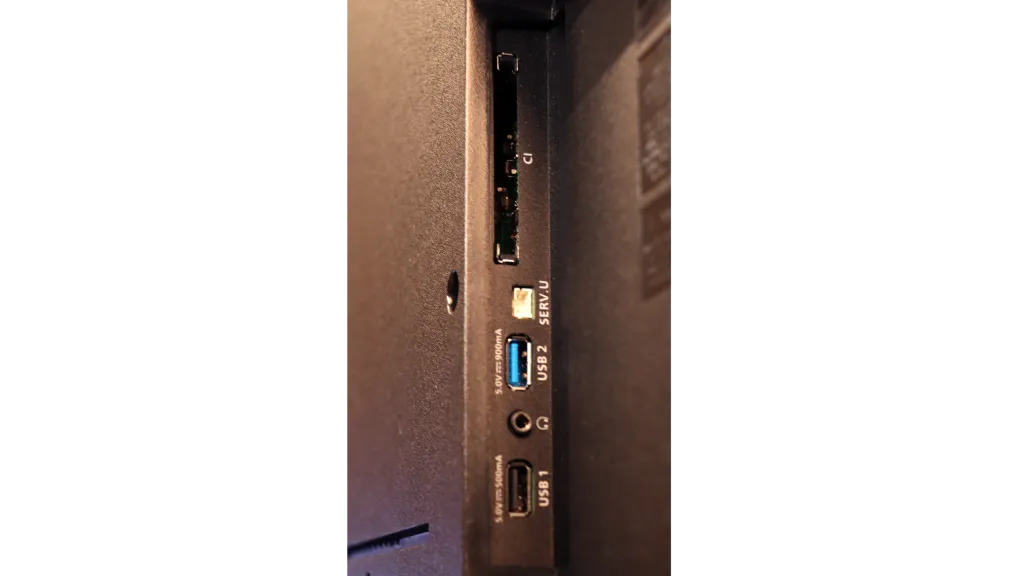
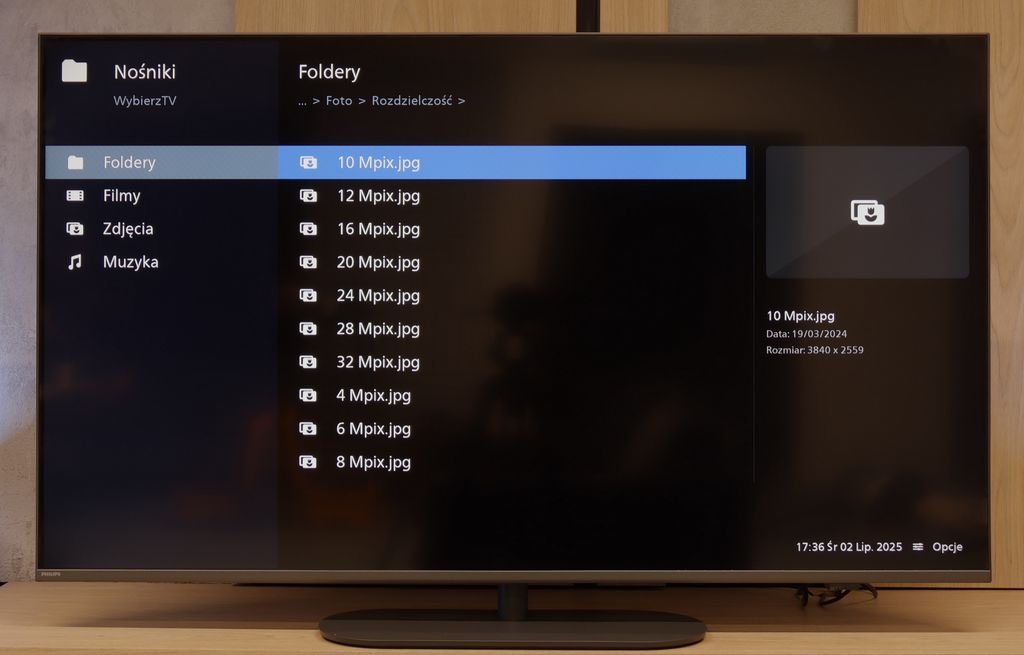
Stand: Fixed
Flat design: No
Accessories: Stand
Philips PUS9000 looks very "classic" – it's a simple television that doesn't try too hard to attract attention. It's not exceptionally slim, but it can be comfortably mounted close to the wall. For those who prefer to place the television on a cabinet, there's a solid, swivel base (although in our test unit, it was slightly tilted to one side, and the screw mounts inside the leg didn't allow for correcting this unwanted tilt). Generally, however, thanks to this base, you can easily angle the screen – towards the couch, kitchen, or anywhere you're watching from. The finish is solid, the thin metal frame looks neat, and the whole thing makes a good impression. But what really transforms the experience of this model in the living room is Ambilight. The LED backlighting at the back of the casing not only enhances the viewing experience but also looks good. With the lights off, it creates a pleasant glow on the wall that can set the mood for the entire room – even when we're not necessarily focused on watching.
Buy in the best price
Select size:
PHILIPS PUS9000 - Contrast and black detail
6.2/10
Local dimming function: No

Result
6,000:1

Result
6,750:1

Result
7,300:1

Result
6,000:1

Result
6,800:1
Visibility of details in the lights:
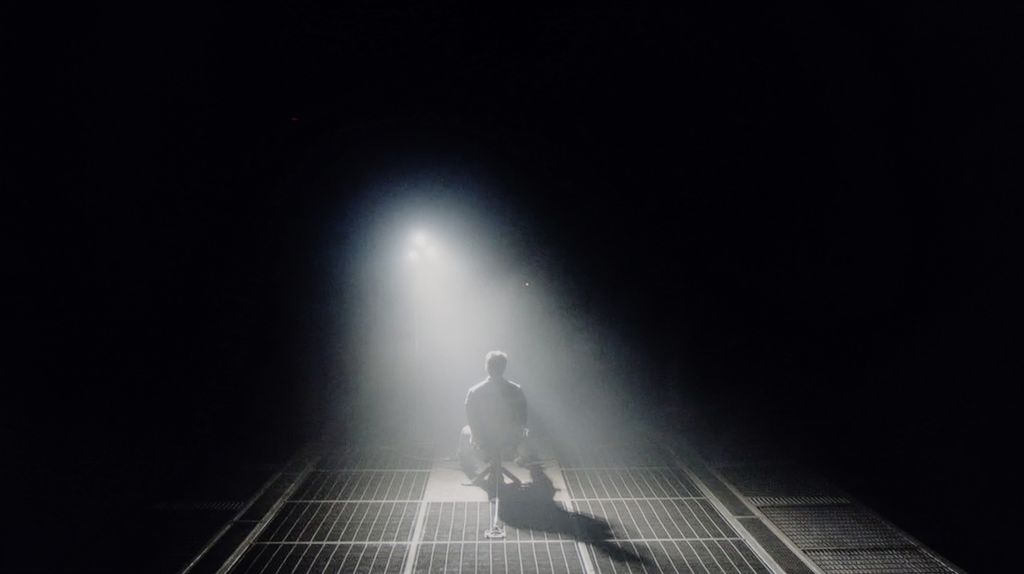
PUS9060 is a television that in this version is equipped with a VA panel – and this is immediately visible in the contrast tests. In the tested screens, the television achieved really good results, at around 6500:1. Such a result speaks for itself, indicating that the television has really decent black levels. Unfortunately, PUS9060 is not equipped with local dimming technology, and as a result – the blacks in dark conditions can appear to resemble a shade of navy. Fortunately, the The One series is known for the famous Ambilight system, which significantly enhances perceived contrast, and consequently – "tricks" our eyes into seeing better blacks. It seems simple, but it is very useful. Therefore, we recommend using this television in the evening with this system turned on. It doesn’t necessarily have to be multicoloured, tracking the image – it can simply be white.
Halo effect and black detail visibility:
PHILIPS PUS9000 - HDR effect quality
5.8/10
Supported formats: HDR10, HDR10+, Dolby Vision, HLG Color gamut coverage: DCI P3: 85.2%, Bt.2020: 62.2%
Luminance measurements in HDR:

Result
507 nit

Result
430 nit

Result
542 nit

Result
551 nit

Result
545 nit
The One is bright enough to enjoy films recorded in HDR format. The average brightness of this model is around 500 nits, so we can easily expect a pleasant viewing experience with films from streaming platforms. Of course—there's always room for improvement, because when it comes to brightness, you can never have too much for this type of content. Unfortunately, a disappointing surprise may be the coverage of the DCI-P3 colour gamut that the PUS9060 offers. Although the manufacturer boasts the use of a QLED filter here (it’s actually PFS LED), it's hard to speak of any positive effects from its operation. 85% coverage of the DCI-P3 gamut is certainly not a level to brag about in 2025—especially in a television marketed as QLED.
Scene from the movie “Pan” (about 2800 nits)

Scene from the movie “Billy Lynn” (about 1100 nits)

As always in our tests, we decided to see how the television handles heavier film scenes, not just dry measurements. And we have to admit that, considering its capabilities, The One performed quite decently. Even though the television slightly brightens the brightest elements – like those from the movie Mr (sun) or the fireworks effect from Billy Lynn – it really recovers details well in those brightest parts of the image. We could nitpick about the less saturated colours or the slightly boosted blacks, but generally, it's not too bad. Given the class of the device – one can be satisfied.
HDR luminance chart:
HDR luminance
HDR10 is definitely not the format that Philips focuses on with The One. That's why the television is equipped with two formats featuring dynamic metadata – and here you can really see the difference in favour of these solutions. The image in Dolby Vision can show significantly more details – for example, a forest in the distance or fine elements like grass. It's also worth noting that if (by some miracle) we can't find a film in Dolby Vision on the streaming platform, Philips has also equipped The One with HDR10+, which works in a very similar way, enhancing contrast and brightness depending on the scene, frame by frame.
Static HDR10

Dynamic: Dolby Vision

Factory color reproduction
5.5/10
We tested the PUS9060 in the best factory mode applied to it – of course, we're talking about the movie mode. Unfortunately, the best in this case does not mean good. The image in this mode was clearly yellowish and leaned towards orange tones. The white balance on this television was definitely too warm, giving the entire scene an artificial, somewhat "tanned" appearance. This directly resulted in significant colour inaccuracies, which in the worst cases exceeded a delta E value of 6 – thus, they were visible to the naked eye. The situation was reversed in HDR mode, where the image became too blue and too cool in perception. Additionally, there was a slight boost in brightness – the gamma curve and EOTF suggested that the television slightly brightens the image, which was also evident in the comparative image below.
Color reproduction after calibration
8/10
Thanks to calibration in movie mode, we managed to completely eliminate the yellow-orange tint, which significantly improved the reception of the entire scene. The image has become much more visually pleasing, though it still falls short of reference settings. It may now appear slightly bluish, but it is still a considerable improvement compared to the factory settings.
Unfortunately, we could not significantly improve the brightness characteristics, but this is more about the design of the television itself - the lack of local dimming limits the possibilities for precise brightness management. The PUS9060 simply cannot dynamically adjust luminance like more advanced models do. Nevertheless, after calibration, the overall reception is much more enjoyable, especially in film material.


PHILIPS PUS9000 - Smoothness of tonal transitions
8.9/10
PHILIPS PUS9060 handles tonal transitions exceptionally well – we didn't notice any serious issues with colour blending. Gradation appears natural, without unpleasant bands or sharp transitions. We could only nitpick on the toughest, darker scenes – there, minimal imperfections appear, but overall it looks quite good, especially for this class of equipment. For most users, the effect will be more than satisfactory.








Image scaling and smoothness of tonal transitions
6.7/10
Smooth transition function
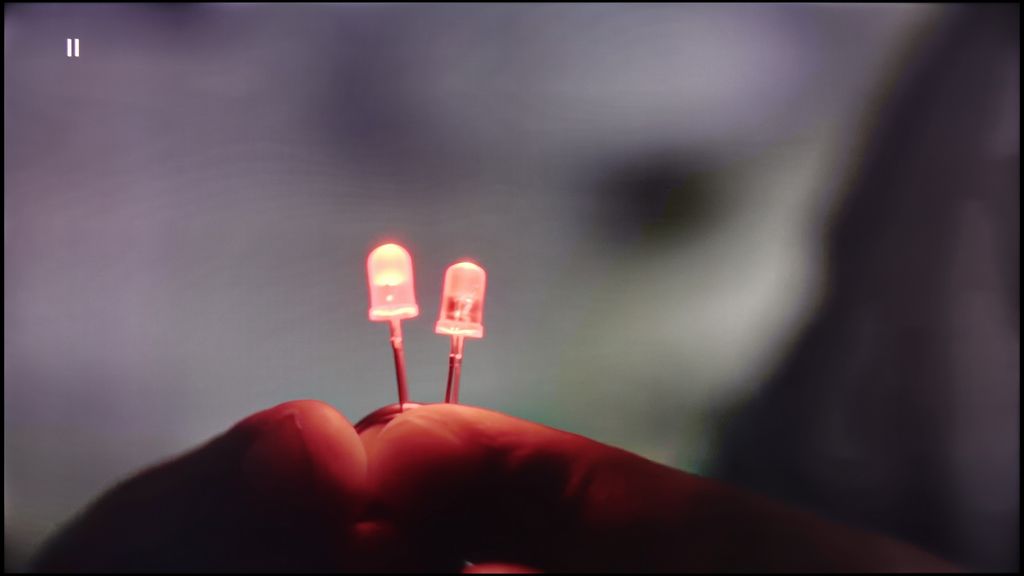
Image without overscan on the SD signal

In the PUS9060, we find another version of the image processor known by Philips as P5 Perfect Picture, which aims to enhance the image – especially the imperfect ones. The TV includes a distortion reduction function, which serves to smooth tonal transitions, meaning those "colour joins" we mentioned earlier. This function does its job very effectively – there’s no strong gradation of colours, but unfortunately, it operates quite aggressively, occasionally dimming desired elements like material textures or film grain. So, it can be seen as a bit of a compromise. We wouldn’t generally recommend using this function for movies, but for more casual content – like YouTube or regular TV – it’s absolutely suitable.
The P5 processor also enhances the quality of lower resolution images, and it does this quite effectively. The test image with the model is very soft – sometimes almost too soft – but this can be easily improved with the sharpness slider, adjusting it to one’s own preferences. It’s also pleasing to see that the TV doesn’t clip the edges in SD materials – which unfortunately still happens in some TV models.
PHILIPS PUS9000 - Blur and motion smoothness
7.5/10
Maximum refresh rate of the panel: 144Hz
Film motion smoothing option: Yes
Blur reduction option: Yes
BFI function 60Hz: No
BFI function 120Hz: No
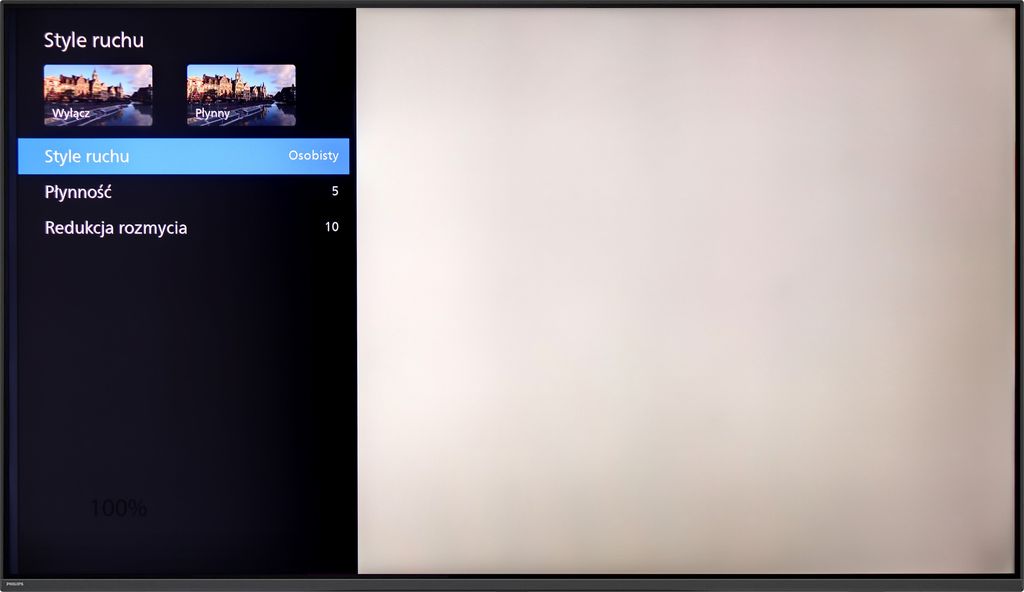
PHILIPS PUS9060 is equipped with a 4K panel featuring a 144 Hz refresh rate, so we can confidently say it’s suitable for both watching sports and gaming. And indeed it is. But what about movies, which are most often recorded at 24 frames? As with most of the TVs we’ve tested with a refresh rate of 120 Hz and above, the PUS9060 offers two sliders in the motion smoothness options. The “Smoothness” slider allows you to adjust the effect in films – you can set the picture to be smoother, resembling a theatrical effect (higher settings), or more cinematic, with a slight “judder” (lower settings). Additionally, there is a feature called "Motion Blur Reduction," which limits motion blur – and this is a very useful feature, especially when watching sports.
Blur (native resolution, maximum refresh rate):



If we're talking about smearing – the television performs quite well for a screen with a VA panel. On bright test screens, it's hard to spot any significant issues. It’s only with darker backgrounds that slight imperfections become visible – this can be observed in the UFO test, where the ship "leaves a trail" behind it.
PHILIPS PUS9000 - Console compatibility and gaming features
9.8/10
ALLM: Yes
VRR: Yes
VRR range: 48 - 144Hz
Dolby Vision Game Mode: Yes
Correct implementation of HGIG: Yes
1080p@120Hz: Yes
1440p@120Hz: Yes
4K@120Hz: Yes
Game bar: Yes
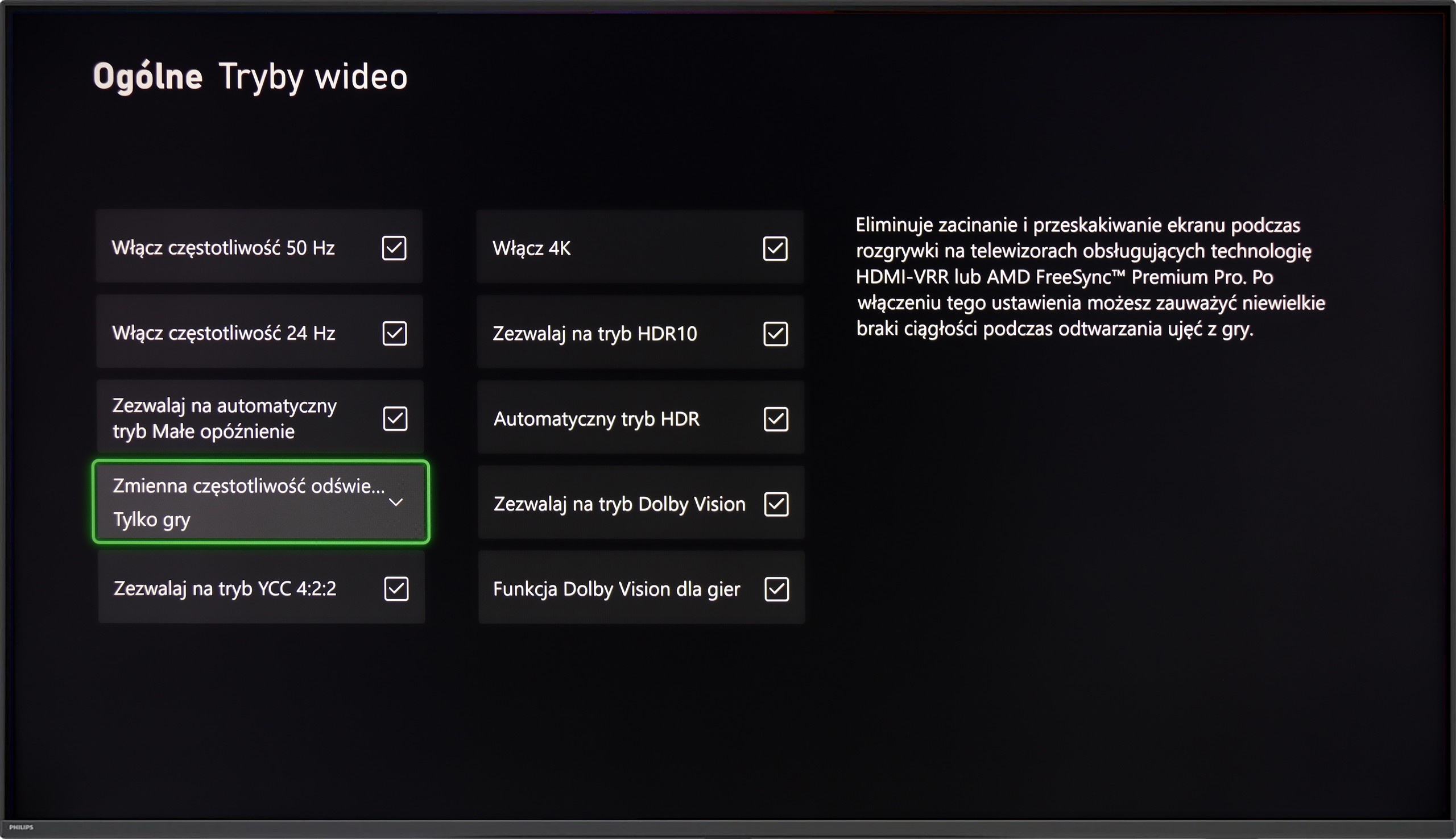
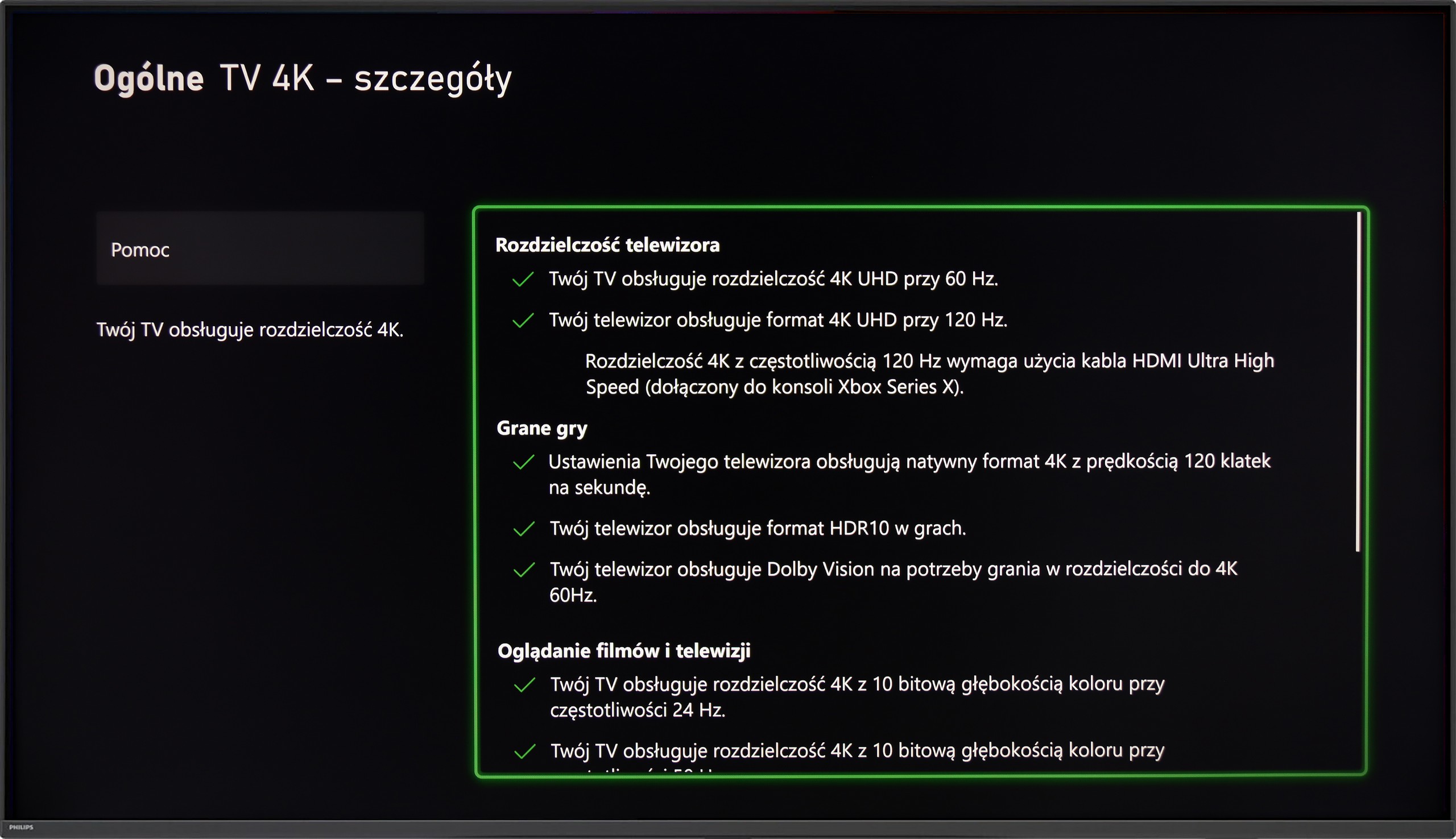
PHILIPS PUS9060 is a true gaming monster – it has practically everything you could expect from a modern gaming television. It features VRR, ALLM, and also includes HGiG implementation, which helps set up HDR in games as intended by the developers. The television supports every possible resolution at 120 Hz, including 1080p, 1440p, and full 4K – so regardless of whether you're playing on Xbox, PS5, or PC, everything works as it should. It also comes with a simple Game Bar, a special menu for gamers that allows you to quickly check if the ALLM mode is indeed working in low latency mode.
And of course – Ambilight TV. Let’s face it – without LEDs on the back, it’s not a true gaming rig. 😉 The multicoloured backlighting really adds to the atmosphere, especially in the evening. It may not appeal to everyone, but younger gamers will be thrilled – it just looks impressive.
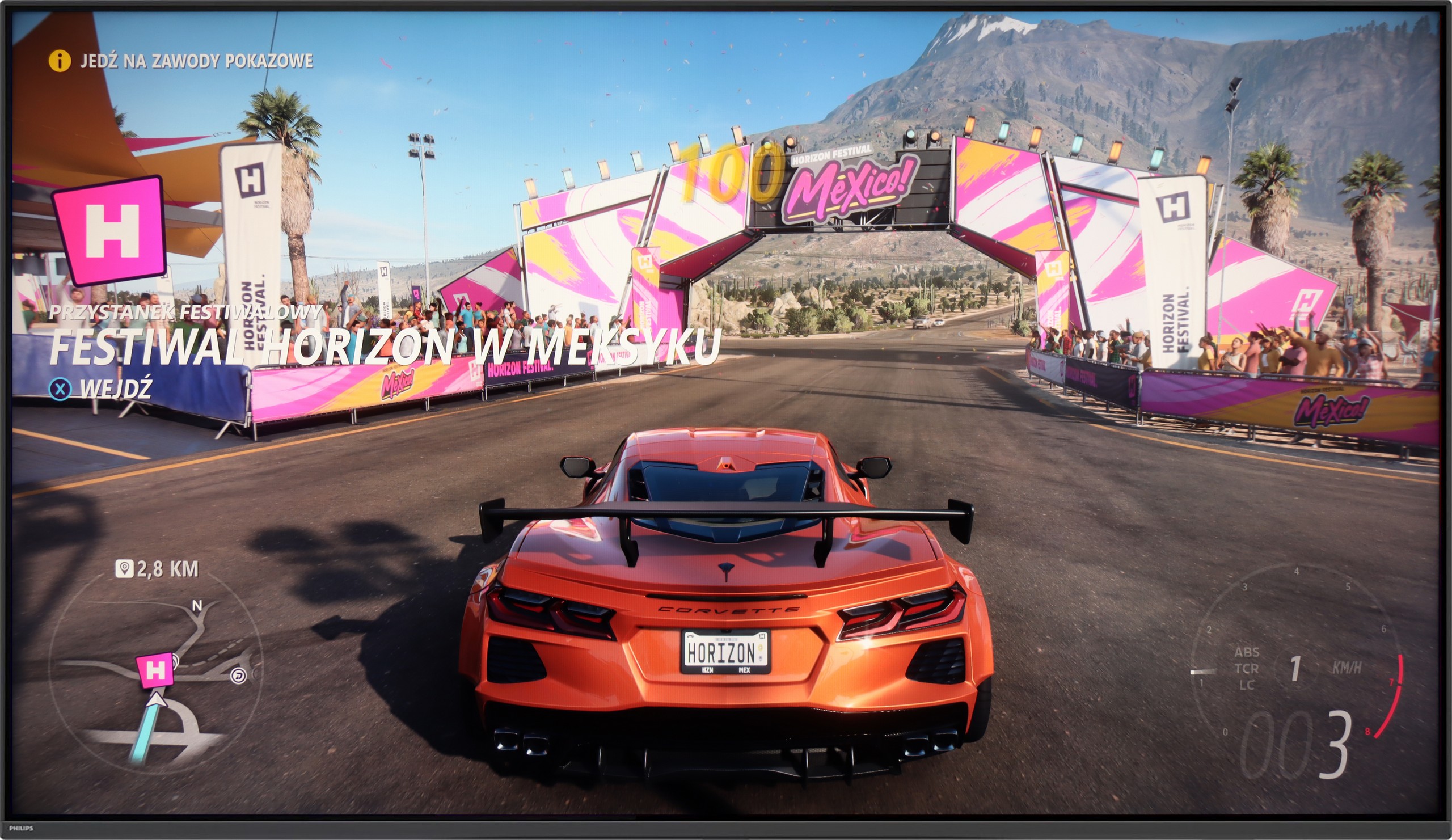
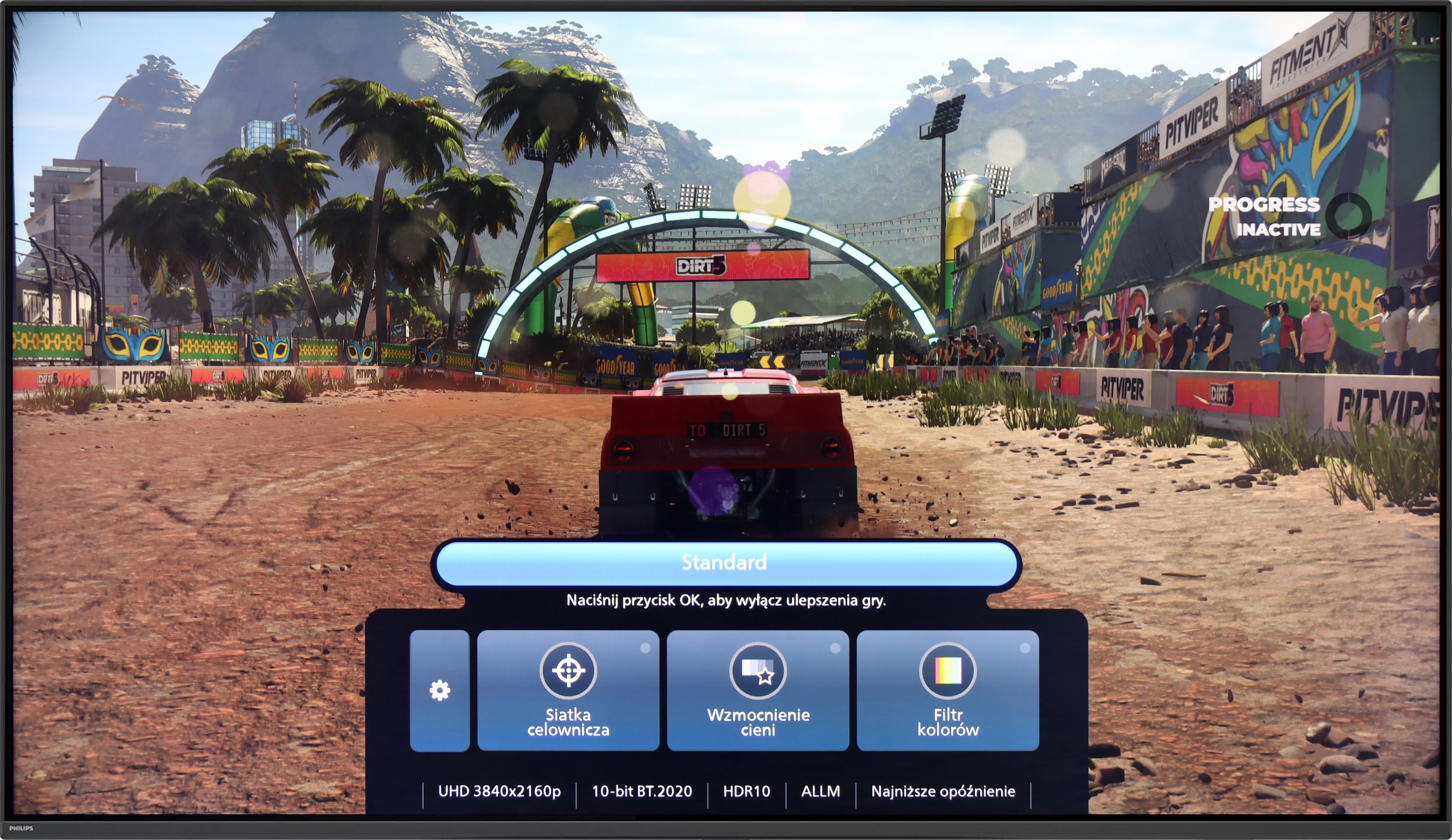

PHILIPS PUS9000 - Input lag
9.5/10
The One from 2025 performs very well in terms of responsiveness. Input lag at around 9 ms at a 120 Hz signal and 18 ms at 60 Hz are values that ensure a quick and smooth response to every movement of the controller. Playing even dynamic action titles or demanding e-sports games is fully comfortable. The situation is slightly worse with Dolby Vision – here, the lag increases to around 33 ms. This is still an acceptable level for most "casual" gamers, but more demanding users may notice a slight slowdown in response. Therefore, in our opinion, a better choice would be the classic HDR10 mode with HGiG active. In this model, it has been implemented correctly and not only avoids delays but also eliminates potential issues with brightness and detail reproduction that sometimes occur in Dolby Vision.
| SDR | HDR | Dolby Vision |
|---|---|---|
| 1080p60: 18 ms | 2160p60: 17 ms | 2160p60 DV: 33 ms |
| 1080p120: 10 ms | 2160p120: 8 ms | |
| 2160p60: 18 ms | ||
| 2160p120: 9 ms |

PHILIPS PUS9000 - Compatibility with PC
8.8/10
Chroma 444 (maximum resolution and refresh rate): Yes
Font clarity: Very Good
Readability of dark text and shapes: Good
Input lag in PC mode (4K, maximum refresh rate): 8ms
Matrix subpixel arrangement: BGR
Max refresh rate: 144Hz
G-Sync: Yes
Using a computer on the PHILIPS PUS9060 should be pure pleasure. As mentioned earlier, the TV performs excellently for gaming on a console, but it also works well in conjunction with a computer. It offers 144 Hz refresh rate, G-Sync Compatible works correctly, and it has low input lag – making it easy to consider this model as a fully-fledged PC gaming monitor.
In terms of everyday work, it’s good as well. Chroma 4:4:4 has been implemented correctly, so fonts are clear and readable. We didn’t notice any issues with text sharpness, although on very dark backgrounds, you can see a slight dimming of letters with a bit of edge doubling. In practice, however, this shouldn’t bother anyone, even while working with text.
PHILIPS PUS9000 - Viewing angles
3.4/10
Brightness drop at an angle of 45 degrees: 65%
The PUS9060 model is equipped with a VA panel, which – as is often the case – does not handle viewing angles very well. With a greater deviation from the axis, the screen brightness noticeably decreases and the colours lose their saturation. Unfortunately, this is a typical compromise compared to IPS panels, which offer better viewing angles but have significantly weaker contrast and blacks. Here, the situation is the opposite – blacks are good, but the angles are very average. Of course, with standard straight-on viewing, there are no issues, but in a larger lounge or with a bigger TV, where someone is sitting far to the side or we are looking at the edges of the screen, the differences will be noticeable.
PHILIPS PUS9000 - TV efficiency during daytime
6/10
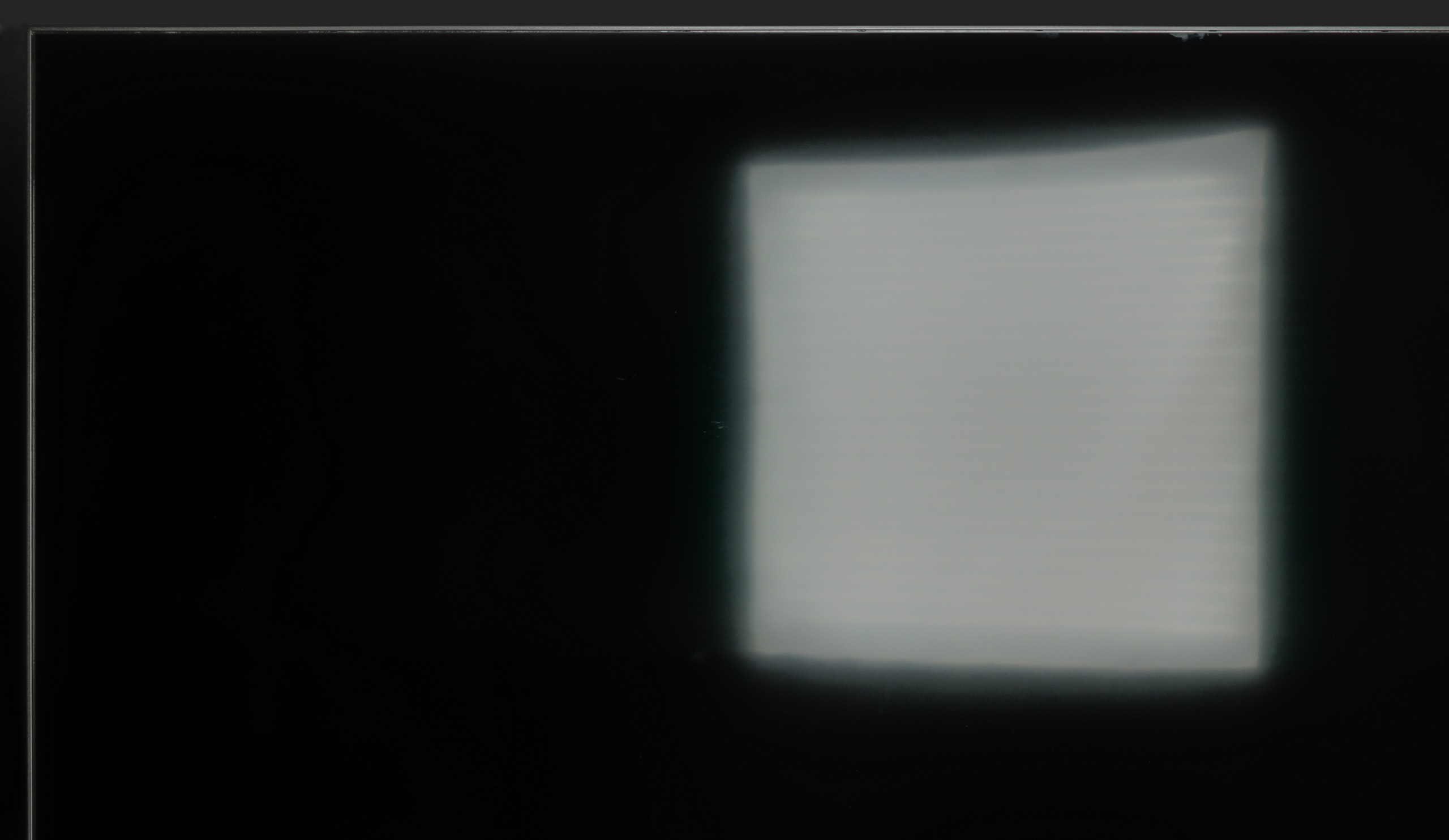

Matrix coating: Satin
Reflection suppression: Decent
Black levels during daytime: Good
Philips PUS9060 performs quite well in a bright room. The satin finish of the screen effectively reduces reflections and glare, so watching in a lounge with numerous lamps or large windows shouldn't pose too many problems. It's also a plus that the blacks don't fade excessively and the picture still maintains decent contrast. The situation could be even better if the TV offered higher brightness. About 500 nits is a decent result, but in very challenging lighting conditions, it may prove insufficient.
Matrix brightness
Average luminance SDR
PHILPS PUS9060: 495 cd/m2
PHILIPS PUS9000 - TV features
5.9/10
System: Titan OS
System performance: Decent
- HDMI inputs: 0 x HDMI 2.0, 4 x HDMI 2.1 48Gbps
- Other inputs: Toslink (Optical audio)
- Outputs: Toslink (Optical audio), eARC (HDMI), ARC (HDMI), Mini-Jack (Headphones)
- Network Interfaces: Wi-Fi 2.4GHz, Wi-Fi 5GHz, Ethernet (LAN) 100Mbps
- TV reception: DVB-T, DVB-T2, DVB-S, DVB-S2, DVB-C
Classic features:
Recording to USB (terrestrial TV): No
Recording programming: No
Picture in Picture (PiP): No
RF remote control (no need to aim at the screen): Infrared
Backlit remote control: Yes
Teletext: Yes
Audio only mode: Yes
Bluetooth headphones support: Yes
Simultaneous Bluetooth headphones & TV audio: No
Smart features:
AirPlay: Yes
Screen mirroring (Windows Miracast): Yes
Voice search: Yes
Voice search in native language: No
Ability to connect a keyboard and mouse: Yes








Classic features of TheOne television:
When it comes to these "classic features," the PUS9060 is quite mediocre. Of course, it has all the basics; there's EPG, teletext, and the ability to connect headphones via Bluetooth. But unfortunately, it lacks USB recording functionality, and there's no PiP (picture in picture) mode, which is becoming less common but still comes in handy. On the plus side, it has a remote with a numeric keypad - modern, backlit, which visually makes a great impression. It's just a pity that it's still a classic infrared model, so to use it, you have to aim directly at the screen. A bit disappointing, as with such a modern look, it really called for Bluetooth (RF) control.
Smart TV:
Most Philips televisions from 2025 run on the Titan OS system, which debuted relatively recently - unfortunately, this still comes with some issues. The system itself operates quite smoothly - definitely better than in cheaper Philips models - and didn't give us any problems when using features like screen mirroring or AirPlay (which isn't a given even in 2025). The biggest downside of Titan OS is still its quite average access to applications (list below). On the plus side, we can bypass this by connecting a keyboard and mouse to the television and using the built-in browser, but it's not the most comfortable solution - rather makeshift.
Sound connection options
HDMI audio:
Other audio outputs:
Toslink: Yes
Stereo (Mini-Jack): Yes
Wireless audio:
Bluetooth: Yes
Obsługiwane formaty audio:
Dolby Digital Plus 7.1: Yes
Dolby True HD 7.1: Yes
Dolby Atmos in Dolby Digital Plus (JOC): Yes
Dolby Atmos in Dolby True HD: Yes
DTS:X in DTS-HD MA: Yes
DTS-HD Master Audio: Yes
Ułatwienia dla seniorów
Numeric keyboard on TV: Yes
Font size adjustment: No
Audio description: No
PHILIPS PUS9000 - Apps
6.2/10























PHILIPS PUS9000 - Playing files from USB
7.9/10

| Maximum photo resolution: | Supported photo formats: |
|---|---|
The built-in player in the PUS9060 played virtually all popular audio and video formats, so it's really hard to find anything to complain about here. Movies in popular containers, music or photos – everything worked without a hitch.
The only thing that might be a bit annoying is the limited number of supported subtitle formats and the randomly selected photo resolutions that the TV can read. But apart from that, most everyday users can easily manage without the need to connect a computer or console to display their files from a USB drive.
PHILIPS PUS9000 - Sound
6.6/10
85dB
Maximum volume
Supported codecs
(TV speakers)
Dolby Digital Plus 7.1
Dolby True HD 7.1
Dolby Atmos in Dolby Digital Plus (JOC)
Dolby Atmos in Dolby True HD
DTS:X in DTS-HD MA
DTS-HD Master Audio
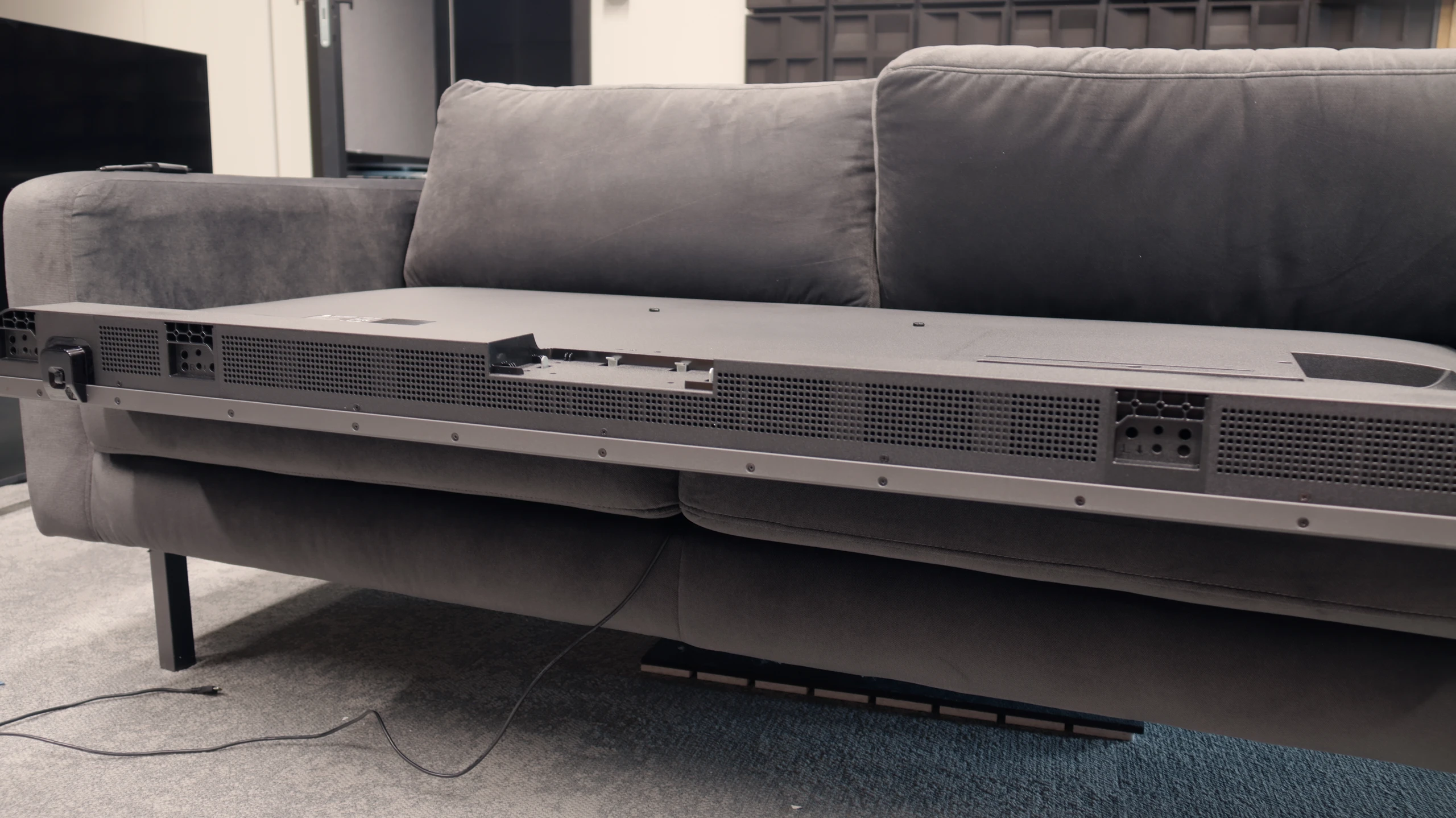
The sound from the PHILIPS PUS9060 was generally pleasant, although it’s hard to call it exceptional. The tested unit had built-in audio in a 2.0 configuration with a total power of 40 W, which is more than enough for everyday viewing. Fortunately, the TV supports most popular audio formats, so if someone connects a soundbar or home theatre system, they can comfortably expect full support for Dolby Atmos or DTS – without any fuss or loss of quality. For true audio enthusiasts, this is definitely good news.
Acoustic Measurements
85dBC (Max)
75dBC
PHILIPS PUS9000 - Details about the matrix
Software version during testing: TPN258E_V058.002.179.041
Subpixel Structure:
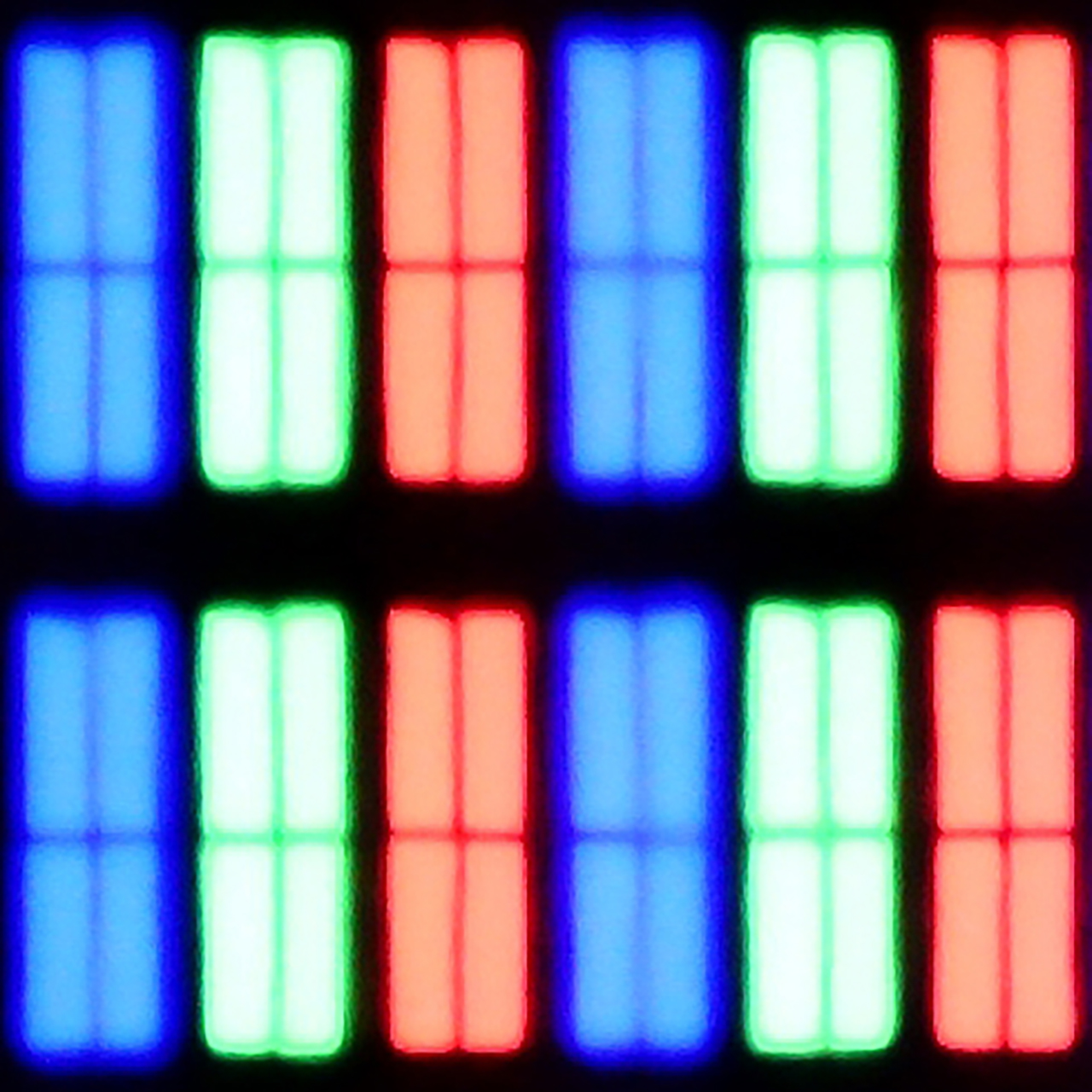
Panel uniformity and thermal imaging:
Backlight Type: PFS LED

Founder and originator of the "ChooseTV" portal

Journalist, reviewer, and columnist for the "ChooseTV" portal
See articles related to PHILPS PUS9060:
4/3/2025
Shopping Reviews
The best Philips TVs of 2024 – these models are worth buying... 5/22/2025
Shopping Reviews
The first Philips TVs of 2025 are already in stores! We know... 6/20/2025











